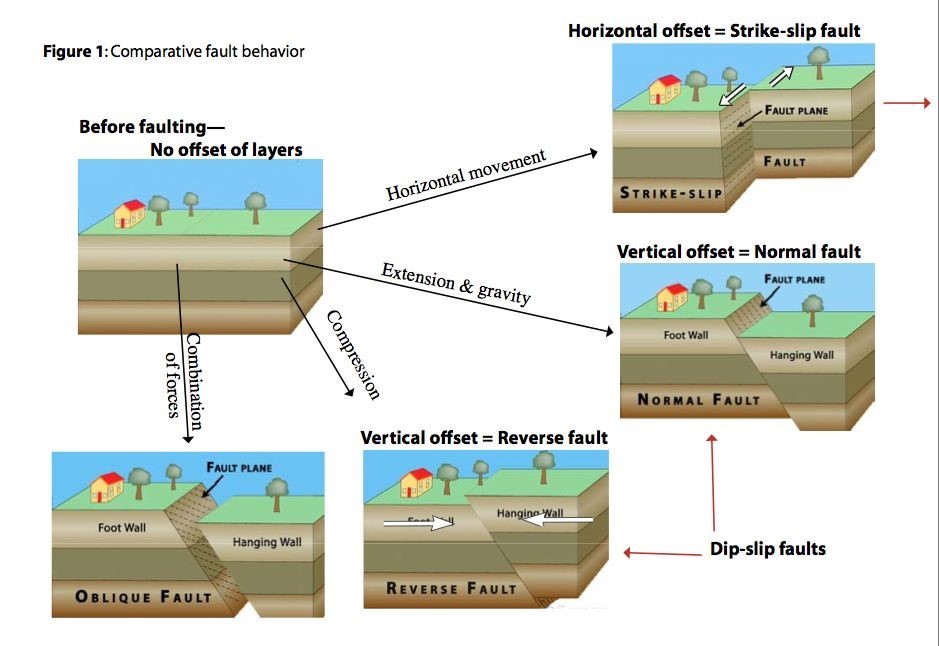ForumIAS announcing GS Foundation Program for UPSC CSE 2025-26 from 19 April. Click Here for more information.
Contents
- 1 What are the reasons behind this dangerous Morocco Earthquake?
- 2 What is India’s susceptibility to Earthquakes like the Morocco Earthquake?
- 3 What are the challenges in Earthquake preparedness in India in the wake of Morocco Earthquake?
- 4 What measures have been undertaken by India to mitigate earthquake destruction in the wake of Morocco Earthquake?
- 5 What Should be the way forward for reduction of destruction due to Earthquakes to avoid destruction like the Morocco Earthquake?
| For 7PM Editorial Archives click HERE → |
Morocco Earthqauke of 8th september 2023 has resulted in casualties of more than 2500 people. This Morocco earthquake has been described as the strongest ever recorded in the mountain region as Earthquakes are relatively rare in North African countries.
What are the reasons behind this dangerous Morocco Earthquake?
The morocco earthquake has a magnitude of 6.8. Its epicentre was located in the Al-Haouz province in the Atlas Mountains of the historic city of Marrakech.
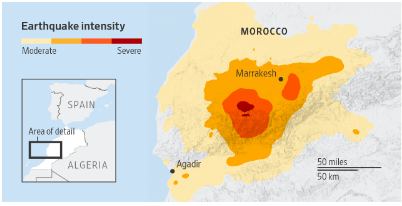
The earthquakes in the North Africa are the result of northward convergence of the African plate with the Eurasian plate along a complex plate boundary.
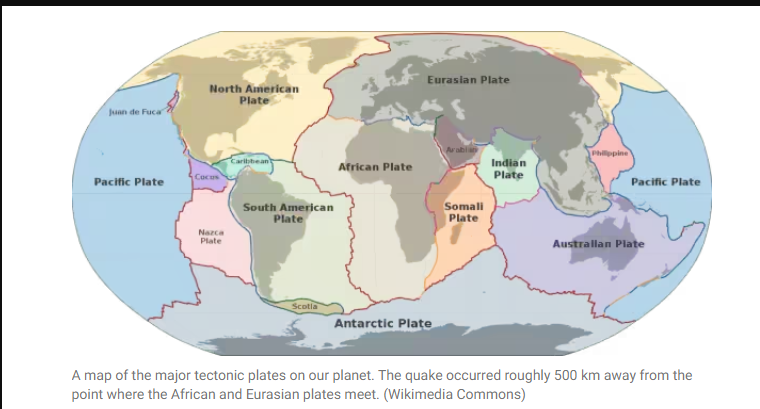
Reasons for Morocco Earthquake
The morocco earthquake resulted from a geological phenomenon called a “reverse fault”. This occurs when tectonic plates collide which cause thickening of the Earth’s Crust. The stress along these fault lines induce earthquakes as rocks abruptly shift to release accumulated stress.
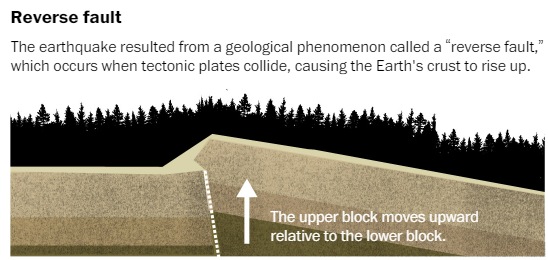
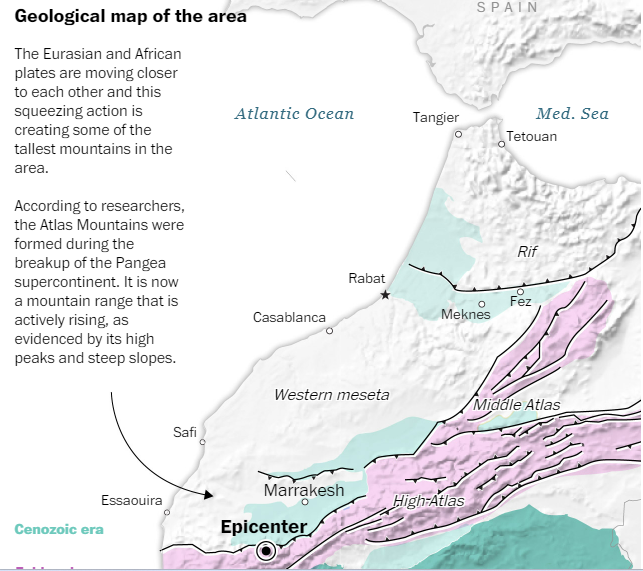
Reasons for High Destruction due to Morocco Earthquake-
The Morocco Earthquake was a Shallow Earthquake.Shallow earthquakes carry a much higher amount of energy when they hit the surface. Whereas earthquakes with deep epicenters lose energy when they hit the surface. Also buildings in rural areas and older cities are not built to withstand the earthquake. Many houses collapsed in Marrakech, a UNESCO World Heritage Site.
Read More-Forum IAS
| Earthquake An earthquake is the shaking of the Earth when two blocks of the earth suddenly slip past one another. The surface where they slip is called the fault or fault plane. The location below the earth’s surface where the earthquake starts is called the hypocenter and the location directly above it on the surface of the earth is called the epicenter. |
What is India’s susceptibility to Earthquakes like the Morocco Earthquake?
The Earthquakes in Turkey and Morocco have brought Earthquake as a disaster in focus. India is also highly susceptible to Earthquakes. The seismic zonation mapping of India also highlights India’s susceptibility to Earthquakes.
Why are some parts in India are more prone to earthquakes
Himalayan belt- Collision between lithological plates Indo-Austral plate with Eurasian plate and Burma Plate with Java Sumatra plate. This collision between two continental plates cause lots of strain in underlying rocks. This strain is released in form of earthquakes
Andaman and Nicobar Islands-Sea floor displacement and underwater volcanoes disturb the equilibrium of earth’s surface.
Deccan Plateau- Some earth scientists have come up with a theory of the emergence of a fault line and energy build-up along the fault line of the river Bhima (Krishna) near Latur and Osmanabad (Maharashtra).
Increasing population and unscientific land use in construction make India a high-risk land for earthquakes.
Seismic Map of India
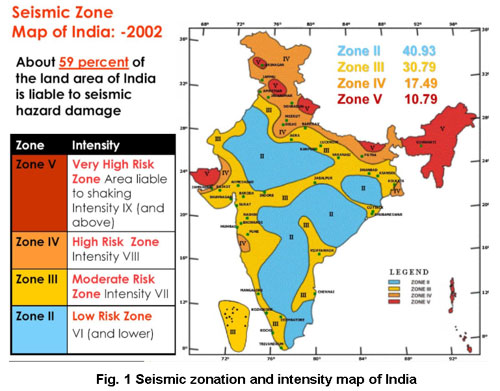
Major Earthquakes In India and frequency of Earthquakes-
Some of the major Earthquakes in India are Cutch Earthquake (1819) which was 8.3 magnitude, Assam Earthquake (1897), Bihar-Nepal Earthquake (1934) of 8.4 magnitude, Koyna Earthquake (1967) of 6.5 magnitude, Uttarkashi (1991) of 6.6 magnitude, Killari Earthquake(1993) of 6.4 magnitude, Bhuj Earthquake (2001) of 7.7 magnitude and Jammu Kashmir Earthquake (2005).
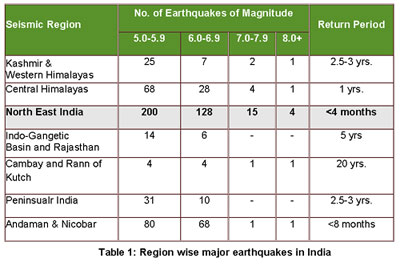
What are the challenges in Earthquake preparedness in India in the wake of Morocco Earthquake?
Structural Challenges
Retrofitting Challenges-The majority of the earthquake prone zone is hilly and mountainous area. Retrofitting is challenging and expensive in these areas.
Lack of proper structural Design-According to NDMA, Ahmedabad’s nearly 4,000 multi-story buildings won’t withstand a high-magnitude earthquake because of poor structural design.
Lack of Skilled Structural Labours-There is a shortage of skilled labour for designing and constructing earthquake-resistant structures.
Governance Challenges
Non Enforcement of Building Codes-Building codes for earthquake resistant buildings are not strictly enforced and safety requirements are no closely maintained. Furthermore the building code ignores the buildings that were constructed before such codes were published in 1962. These buildings form a large part of our cities.
Laxity in granting licenses to structural engineers-The licencing of structural engineers based on competency is not implemented properly.Buildings are not constructed with the help of certified structural engineers.
Lack of proper coordination-There are difficulties in coordinating the response to disasters in India. Example-Uttarakhand floods highlighted the shortcomings of disaster management in India. that the disaster response system has shortcomings.
Lack of awareness among the local population-The post disaster response is not properly implemented by the local population due to lack of awareness.
What measures have been undertaken by India to mitigate earthquake destruction in the wake of Morocco Earthquake?
According to the seismologists the earthquake itself is not the killer but it is the unpreparedness among the society and government in terms of inadequate infrastructure which kills thousands of people.
National Building Code (NBC) for India’s Earthquake preparedness-India has set building regulations and requirements for construction that are earthquake resistant which are contained in the National Building Code of 2005.
National Retrofit Program for India’s Earthquake preparedness-National Retrofitting Program was introduced by the Home Ministry in 2014.The RBI had instructed the banks to refuse loans to any construction that does not adhere to the regulations for earthquake-resistant structures.
National Disaster Management Authority (NDMA)-The Disaster Management Act was passed in December 2005.The Disaster Management Act called for the establishment of State Disaster Management Authorities (SDMAs) led by the respective Chief Ministers to carry out similar functions at the state level and the National Disaster Management Authority (NDMA) to oversee earthquake disaster management efforts in India.
Launch of mobile apps-The government launched two Mobile apps –‘India Quake’ for dissemination of earthquake parameters and ‘Sagar Vani’ to disseminate ocean related information and alerts (like high waves and Tsunami early warnings) to the user community in timely manner for their safety.
What Should be the way forward for reduction of destruction due to Earthquakes to avoid destruction like the Morocco Earthquake?
Earthquake monitoring centres-Earthquake monitoring centres (seismological centres) must be established for regular monitoring and fast dissemination of information among the people.
Preparation of Vulnerability Map-Vulnerability map of the country must be prepared and vulnerability risk information must be disseminated among the people to educating them about the ways and means minimising the adverse impacts of disasters.
Modification of houses in High Risk Areas-The house types and building designs in the vulnerable areas must be modified and construction of high-rise buildings, large industrial establishments and big urban centres must be discouraged.Ex-Traditional housing designs like Khasi Housing design of Assam.
Incorporation of learnings from Japan-Ensuring strict compliance of earthquake resistant buildings (80% in Japan).Use of earthquake early warning system which triggers an alert when seismic waves are detected. Since electric signals travel faster than seismic waves, the lead time is used to alert people via media, internet and trains, elevators, industrial machines are automatically stopped.
Providing tax Incentives-The governments must grant tax breaks and provide financial relief to corporates and individuals who construct structures with earthquake resistance.
Empowerment of Local Bodies and communities-The skills and capabilities of the local community must be enhanced through the empowerment of panchayats and municipal corporations in earthquake management.
Use of International Institutions and mechanisms-Countries must incorporate the Sendai Framework for Disaster Risk Reduction in framing their policies of disaster management. Joint exercises of international organisations like SCO JtEx-2019 of SCO or the BIMSTEC Disaster Management Exercise must be used for disaster management and mitigation.
Further Reading-Morocco Earthquake The Hindu

